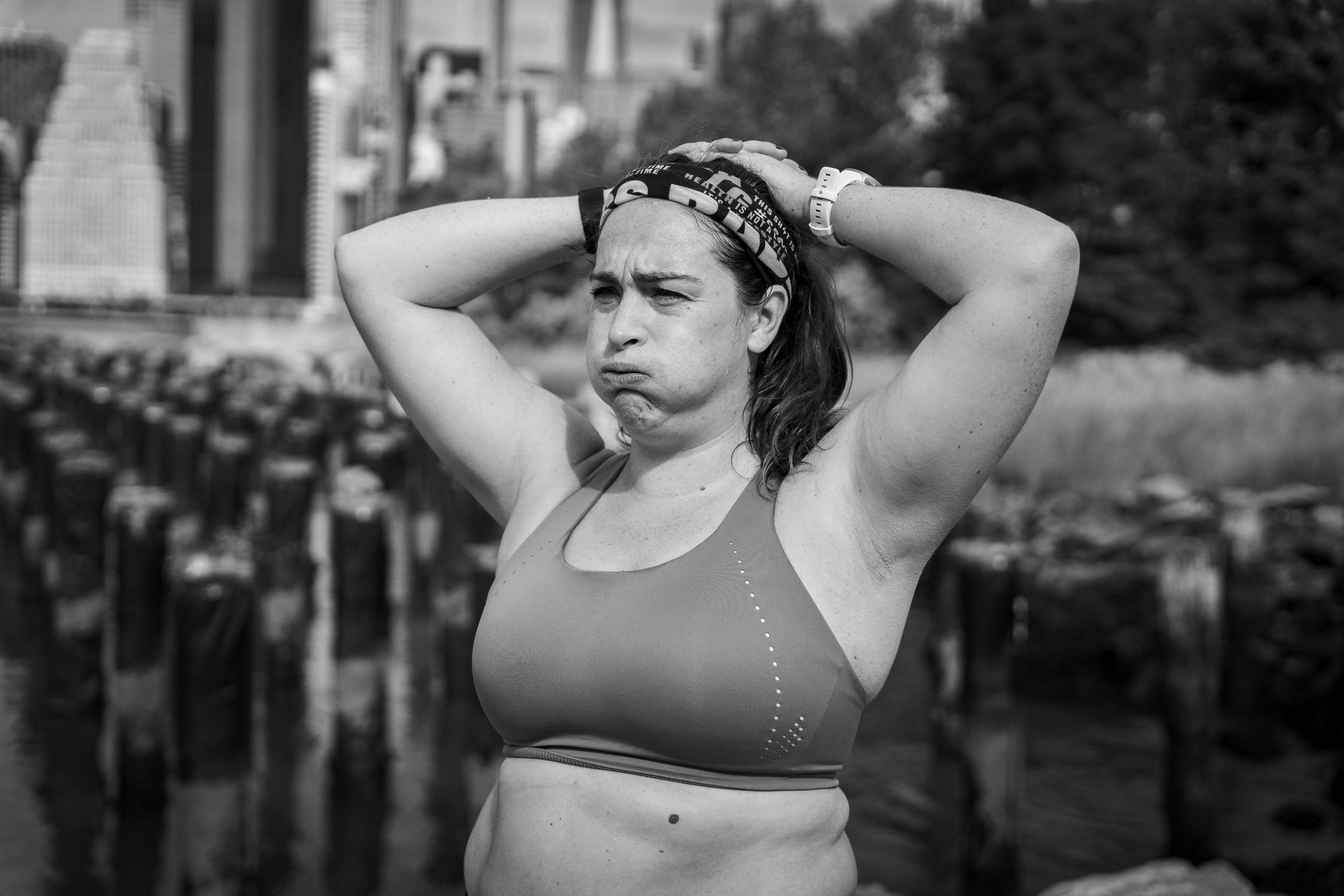When Running How Should I Breathe?
Breathing is one of the most natural things we do, but for many runners, it can become a challenge that significantly impacts their performance. (OR, you see someone talk about it on social media and get the idea that you’re breathing wrong in your head.) Whether you’re a beginner or an experienced runner, understanding how to breathe properly can enhance your running efficiency, reduce fatigue, and make your runs more enjoyable. Let’s explore various breathing techniques, common pitfalls, and tips to help you breathe easier while running. But remember, when in doubt, K.I.S.S.—Keep It Simple Stupid. You already know how to breathe and breathe great. Don’t lose sleep over it.
The Basics of Breathing
Why Is Proper Breathing Important?
Breathing efficiently while running ensures that your muscles get the oxygen they need to perform. Improper breathing can lead to side stitches, fatigue, and a drop in performance. Efficient breathing maximizes oxygen intake and minimizes the energy expended on breathing itself.
Anatomy of Breathing
Breathing involves the diaphragm, intercostal muscles, and lungs. The diaphragm is a dome-shaped muscle at the base of your lungs that contracts and flattens when you inhale, allowing your lungs to expand. The intercostal muscles between your ribs also play a role in expanding and contracting the chest cavity.
Techniques for Effective Breathing
Diaphragmatic Breathing
Also known as belly breathing, diaphragmatic breathing engages the diaphragm more than the chest. This technique allows for deeper breaths and more efficient oxygen exchange.
How to Practice Diaphragmatic Breathing:
Lie on your back with one hand on your chest and one on your belly.
Take a deep breath in through your nose, focusing on expanding your belly rather than your chest.
Exhale slowly through your mouth.
Practice this for a few minutes daily until it becomes natural.
Rhythmic Breathing
Rhythmic breathing synchronizes your breaths with your running steps. This technique helps distribute the impact of running more evenly across your body, reducing the risk of injury.
Common Rhythmic Breathing Patterns:
3:2 Pattern: Inhale for three steps, exhale for two. This pattern works well for easy runs and long-distance training.
2:1 Pattern: Inhale for two steps, exhale for one. This pattern is useful for faster runs and sprints.
Mouth vs. Nose Breathing
There’s often debate about whether to breathe through your nose or mouth while running. The truth is, it’s best to use both, especially when running at higher intensities.
Why Use Both?
Nose Breathing: Filters and humidifies the air and is more efficient for lower-intensity runs.
Mouth Breathing: Allows more oxygen intake during higher-intensity efforts.
360-Degree Breathing
360-degree breathing is a technique that involves expanding your rib cage in all directions—forward, sideways, and backward—when you inhale. This method allows for a deeper and more efficient intake of oxygen, which can enhance running performance.
Benefits of 360-Degree Breathing
Increased Lung Capacity: Allows for fuller oxygen exchange.
Improved Posture: Encourages proper alignment, reducing tension in the upper body.
Enhanced Relaxation: Promotes a calm and controlled breathing pattern.
How to Practice 360-Degree Breathing
Find a Comfortable Position:
Sit or stand with your back straight and shoulders relaxed.
Place Your Hands:
Put one hand on your chest and the other on your belly to feel the movement.
Inhale Deeply:
Breathe in through your nose, focusing on expanding your rib cage outward in all directions. Feel your chest, sides, and back rise as you inhale.
Exhale Fully:
Breathe out through your mouth, allowing your rib cage to contract naturally.
Practice Regularly:
Incorporate this technique into your warm-up and cool-down routines, and practice during easy runs to make it a natural part of your breathing pattern.
Tips for Integration
Start Slow: Begin practicing 360-degree breathing in a controlled environment before integrating it into your runs.
Consistency is Key: Regular practice will help make this breathing technique second nature.
Monitor Your Progress: Pay attention to how this technique impacts your overall running performance and comfort.
Tips for Better Breathing
Maintain Good Posture
Good posture facilitates better breathing. Keep your shoulders relaxed, back straight, and head up. Slouching can restrict your diaphragm’s movement and reduce lung capacity.
Warm Up Properly
Warming up increases your heart rate and prepares your respiratory system for more intense activity. Incorporate dynamic stretches and light jogging before your main run.
Stay Relaxed
Tension in your body can lead to shallow breathing. Focus on staying relaxed, especially in your shoulders and neck, to facilitate deeper, more efficient breaths.
Practice Breathing Exercises
Regular breathing exercises can improve your lung capacity and make efficient breathing more natural during runs.
Example Exercise:
Box Breathing: Inhale for four counts, hold for four counts, exhale for four counts, hold for four counts. Repeat for several minutes.
Common Breathing Issues and Solutions
Side Stitches
Side stitches are sharp pains under the ribcage, often caused by shallow breathing or eating too close to running.
Solutions:
Practice diaphragmatic breathing.
Avoid eating large meals 2-3 hours before running.
Slow down, drop the arm on the side stick, and take deep breaths if a stitch occurs.
Shortness of Breath
Shortness of breath can occur if you’re running too fast or not breathing efficiently.
Solutions:
Slow your pace to a conversational level.
Remind yourself that you can breathe, that you are safe, and that you are ok.
Focus on rhythmic breathing patterns.
Build your aerobic base with easy, steady-state runs.
Hyperventilation
Hyperventilation is rapid, shallow breathing that can lead to dizziness and panic.
Solutions:
Slow down and focus on deep, diaphragmatic breaths.
Practice calming techniques like box breathing.
Remind yourself that you can breathe, that you are safe, and that you are ok. If you are prone to panic attacks or hyperventilation, visualize and prepare for what to do should your breathing trigger a panic attack. If possible, work with a therapist or professional when working through what to do.
Breathing Tips for Different Types of Runners
Tips for Beginners
Start Slow: Focus on building your aerobic base with easy runs.
Practice Diaphragmatic Breathing: Make belly breathing a habit.
Stay Relaxed: Avoid tensing up, especially in the upper body.
Tips for Intermediate Runners
Incorporate Rhythmic Breathing: Use patterns like 3:2 or 2:1 to find what works best for you.
Mix Up Your Runs: Include interval training and tempo runs to improve breathing efficiency at different intensities.
Stay Consistent: Regular practice will improve your breathing over time.
Tips for Advanced Runners
Optimize Your Form: Maintain good posture and stay relaxed to facilitate efficient breathing.
Use Breathing Exercises: Regularly practice exercises like box breathing to enhance lung capacity.
Monitor Your Breathing: Pay attention to your breathing patterns and adjust as needed during different types of runs.
Breathing and Performance
How Breathing Affects Performance
Efficient breathing can enhance your running performance by ensuring your muscles receive adequate oxygen and reducing the risk of fatigue. It also helps maintain a steady pace and prevents common issues like side stitches and shortness of breath.
Monitoring Your Progress
Keep track of how your breathing techniques impact your runs. Use a journal or a running app to note any improvements or areas that need work. Monitoring your progress helps you make necessary adjustments and see the benefits over time.
Train with the Badass Lady Gang
At the Badass Lady Gang, we’re committed to helping you achieve your running goals with the right support and resources. Whether you’re just starting out or aiming for a marathon PR or getting overwhelmed by figuring everything out, we’ve got you covered.
Training Team
Join our training team for personalized coaching, multiple weekly coaching calls, and a supportive community. Our team helps you stay accountable and motivated throughout your training.
Running Plans
Our running plans cater to all experience levels and goals, from beginners aiming for their first 5K to advanced runners training for marathons. These plans are designed to provide structure and progression, ensuring you improve safely and effectively.
Strength for Runners Subscription
Our strength for runners subscription offers targeted strength workouts that complement your running training. These workouts help you build the power and resilience needed to run faster and prevent injuries.
Training Experiences
Join our training experiences for immersive, comprehensive programs that include structured training plans, coaching, and community support. These experiences are designed to help you achieve specific running goals, such as completing a marathon or improving your 10K time.
TLDR
Breathing is a fundamental aspect of running that can significantly impact your performance and enjoyment. By understanding and practicing effective breathing techniques, maintaining good posture, and staying relaxed, you can enhance your running experience.
Remember, keep it simple and trust that you don’t need to overthink it. When in doubt, K.I.S.S. (Keep It Simple Stupid). With the right approach and support from the Badass Lady Gang, you’ll be running stronger and breathing easier in no time.
Join the Badass Lady Gang today to access our training resources and become part of a community that supports and inspires you every step of the way. Let’s run strong and breathe easy together!










Learn the no-BS basics of runner fueling from Coach Kelly. Discover what to eat during long runs, how much fuel you actually need (30-90g carbs/hour), and why practice matters. Skip the guesswork with simple strategies for real food vs gels, hydration tips, and common mistakes that sabotage your runs. Perfect for beginners ready to fuel like a pro.